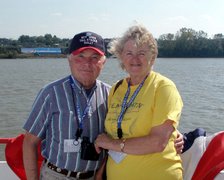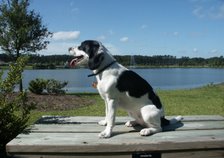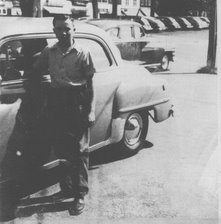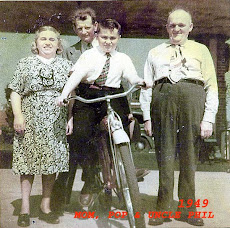On Aug 4
th we arrived in Hungry Horse, MT at the western entrance to Glacier National Park, having traveled a total of 2,680 miles. We drove Going-to-the-Sun road twice in total; it is a 50 mile scenic drive through the park connecting East and West sides of the park. US 2 also connects east and west, but it skirts the park. Along this road, which connects Maine with Washington state, is
Marias Pass, on the Continental Divide, 5220 ft high, just 20 miles from Lewis' July 22-25, 1806 campsite. The Corps of
Discovery's history would have been significantly changed had Lewis discovered this pass through the Rockies. Before this road was built, the only way for cars to travel this route near Glacier is by loading them on railroad cars. The rail link was started in 1890 after John Stevens, principal engineer of the Great Northern Railway, discovered the pass. It is now part of the
BNSF.
Marias Pass has a monument to Stevens as seen below.


Below is a picture of our
motorhome as we arrived at Glacier National Park via US 2 and
Marias Pass.

Again, we spent a week here and the time just flew. Just about every day we hiked. Our hikes included Baring Falls, Hidden Lake,
Swiftcurrent, Virginia Falls, and Avalanche Lake. We were able to visit most of the park, including the areas along the Going-to-the-Sun road, Two Medicine and Many Glaciers. Prettiest of all was Virginia Falls. The biggest surprise in this park was the number and variety of flowers. As the name would indicate, one would expect to at least walk upon or touch a glacier; no sir! They are rapidly disappearing and remain
inaccessible, at least to people like us, who have to view them through a binocular. Another big surprise was the number of people visiting the park. Roosevelt Park had
comparatively few visitors and was enjoyable to visit all the areas. At Glacier, there was a traffic jam along the 50 miles of the Sun road. This was partly due to construction along the road, but even where there wasn't any, it was bumper-to-bumper. At Logan Pass there was a 30 minute wait just to get a parking space. If we didn't have handicap permit, we'd still be waiting to park. The Park Service was of no help in
alleviating the congestion. So, to see what we did, we really needed the full week.
Traveling the Going-to-the-Sun road, at Logan Pass, 6,646 ft, we took a nice vigorous hike to Hidden Lake as shown below.



Below is Jefferson Glacier is shown below as seen from the Sun road. We are told that by 2020 there will be no glaciers left in the park. Not to worry though, for the scenery is absolutely beautiful none-the-less.

Below are some pictures of our 5.2 mile hike to Avalanche Lake, along Avalanche Creek. The trail started along a boardwalk then took us along the creek to the lake where one can see three waterfalls going into the lake. It was a difficult (for us elevations are always difficult) but wonderful hike, the view of the lake and waterfalls being worth the effort.




We drove to Two Medicine Lake on the east side via US 2 and took a boat ride and ranger guided hike to Twin Falls. There are two falls here, but I was only able to get in one at a time, so I'm just including the best one, which is of course, the one in which we were in.


On Friday, Aug 7th, while my wonderful wife was in Mountain Meadow campground doing the laundry, I went white water rafting on the Flathead River. It was great fun and I enjoyed it immensely. In the picture below, I'm sitting up front on port side, wearing a PFD which looks too big for me and my Tillie hat.

We took the Sun road to the east entrance and then went north to the Many Glacier area. We hiked around
Swiftcurrent lake, saw a hen grouse with several chicks and got my great picture of a brown bear from the car. He was just walking along the side of the road unconcerned about the guy in the Honda taking his picture.




Below are some scenes along the Sun road. I am standing by a red park bus in my new Glacier T-shirt that has a picture of a red bus on it. I also got a great picture of a big horn sheep, again from the car while on the Sun road, who was just inches from us. The mountain goat was by a trail just off the Sun road.




I mentioned the beautiful flowers in the park, here is a sampling.





The most beautiful and spectacular waterfall that we saw was Virginia Falls. The trail is near St. Mary at the eastern entrance and includes St. Mary Falls , seen on the right, as well. It's a three plus mile trail with a 550 feet elevation change. As with Avalanche Lake, the scenery was worth the effort; and we saw two falls close up on one hike.


Benton Chalet is the winner of the National Trust for Historic Preservation Honor Award 2000. Located at the West entrance of the Park, The Great Northern Railway Chalet opened in 1910, the same year as the Park. It was used by the railroad as a destination for passengers visiting Glacier. Using Swiss chalet styling, the Great Northern Railway hoped to lure Swiss/Alps bound vacationers to Glacier via its passenger service. Today, Benton Chalet offers both lodging and fine dining. We ate there twice, savoring rack of lamb, elk and pork.


On Aug 11 we left Mountain Meadow Campground in Hungry Horse, MT and headed for Three Forks, MT where the Lewis and Clark Expedition camped at the Headwaters of the Missouri.










































































.jpg)










